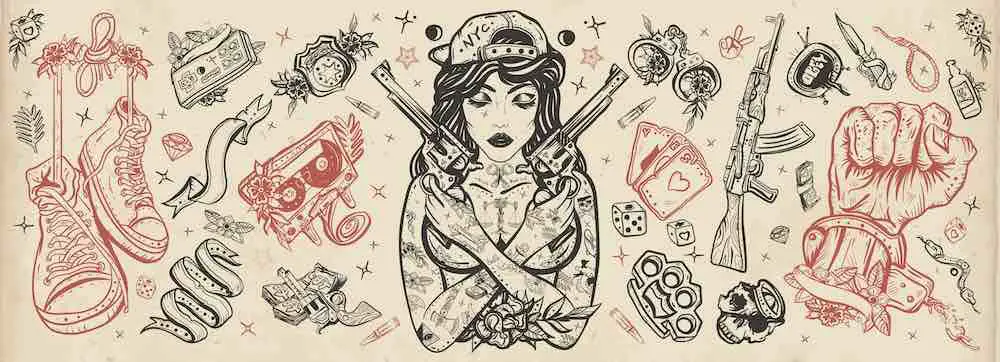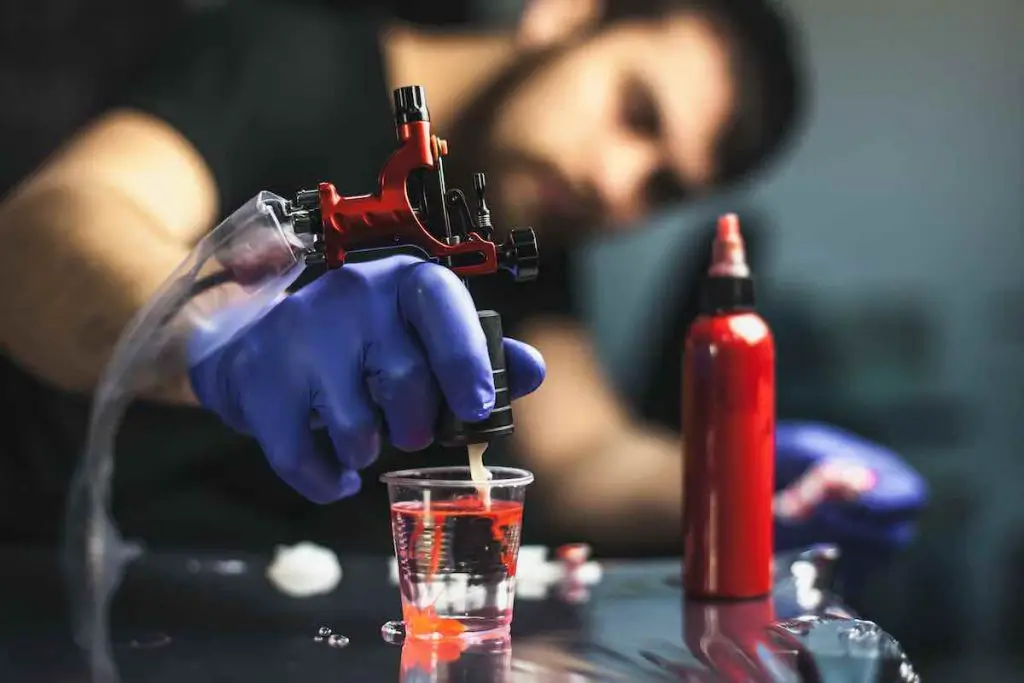Hawaiian tattoos are deeply rooted in the culture and heritage of the indigenous people of the Hawaiian Islands. These tattoos not only represent the individual’s connection to their ancestors and the land, but they also serve as a display of spirituality, social status, and personal identity. Traditional Hawaiian tattoos involve the skillful use of bold designs, mainly in black, incorporating geometric patterns, like triangles and swirls.

The art of Hawaiian tattooing carries with it an esteemed history, often involving a blend of religious devotion and the warrior spirit. The techniques used in Hawaiian tattooing have evolved over time, while still retaining their significance. Nowadays, Hawaiian designs often intermingle with other Polynesian styles, like Maori, Samoan, and Marquesan, showcasing an array of symbols that each carry unique meanings.
Key Takeaways
- Hawaiian tattoos embody cultural heritage, spirituality, and personal identity
- Traditional designs feature bold black patterns and an intricate association with history
- The art has evolved, intermingling with other Polynesian styles, and carries unique symbolic meanings
History of Hawaiian Tattooing
Origins in Polynesian Culture
Hawaiian tattoos, also known as kākau, find their roots in the broader Polynesian culture. The practice of tattooing has been an integral part of the Polynesian people’s identity, and its history spans thousands of years. Hawaiian tattoos share common elements with other Polynesian tattoo traditions, such as those from Maori, Samoan, and Marquesan cultures. Over time, each region developed its distinct tattoo styles and techniques, influenced by their beliefs, customs, and environment.
Ancient Hawaiian Practice
In ancient Hawaii, tattoos played a crucial role in representing social status, family lineage, spirituality, and personal achievements. The designs and placement of the tattoos varied between men and women. Men’s tattoos were often more extensive, covering their entire body, while women usually had tattoos on their hands, fingers, wrists, and sometimes on their tongues.
Tattooing in ancient Hawaii was a sacred process, where the tattooist, or kahuna, was specially trained and held a high social status. Interestingly, the kahuna would determine the design and placement of the tattoo, not the client. This meant that every tattoo was unique, reflecting the individual’s identity and story within the context of their community and culture.
Influence of Samoan and Marquesan Tattoos
Hawaiian tattooing owes much of its history and development to the interaction with, and influence of, Samoan and Marquesan tattoo traditions. Samoan tattoos, or tatau, are known for their intricate patterns covering large areas of the body. These tattoos hold deep cultural significance and have strict rules about their application, with only a select few allowed to become tattoo artists or tufuga.
Similarly, Marquesan tattoos feature geometric patterns and animal motifs, reflecting the people’s closeness to nature and spiritual beliefs. Many of the symbols and design elements found in Hawaiian tattoos can be traced back to these Polynesian tattoo traditions, showcasing the interconnectedness of these cultures and the sharing of knowledge, ideas, and techniques over the centuries.
Hawaiian Style Tattoo Designs
Traditional Symbols and Their Meanings
Hawaiian tattoos often incorporate traditional symbols that hold deep cultural significance. Some of the most common symbols found in Hawaiian tattoos include:
- Tiki: The Tiki represents the first man in Hawaiian mythology and is known for its fierce expression, acting as a guardian against evil spirits.
- Triangles: Triangles are often used to represent shark teeth, which symbolize protection, strength, and courage.
- Sea Turtles: These creatures are known for their long life and wisdom, making them a popular choice for tattoos.
- Hibiscus Flowers: This beautiful flower represents the fragile and fleeting nature of life and is often used to symbolize femininity.
Geometric Patterns
Geometric patterns are a common feature in Hawaiian tattoos, reflecting the intricate weaving and quilting techniques found in traditional Hawaiian arts. These patterns can range from simple shapes to complex arrangements, often with symbolic meaning. Some popular geometric patterns include:
- Samoan-inspired geometry: Similar to Polynesian-style designs, Samoa-inspired patterns often feature repeating shapes and lines, representing nature, family, and other important cultural elements.
- Fine line designs: Another popular style is the use of fine lines to create intricate patterns, often inspired by the flora and fauna of the Hawaiian islands. These designs can be quite striking, especially when combined with other symbols and elements.
Incorporating Other Polynesian Elements
Hawaiian tattoos can also include elements from other Polynesian cultures, incorporating various symbols and motifs to create unique designs. Some examples of Polynesian-inspired elements include:
- Maori-inspired patterns: The Maori people of New Zealand have a rich tattooing tradition, and their designs often feature striking patterns, like the koru (spiral) and kowhaiwhai (curved designs), which can be incorporated into Hawaiian tattoo designs.
- Mandalas: Although not exclusive to Polynesian cultures, the mandala is a popular choice for incorporating geometric patterns and symbolizing the balance between the self and the universe.
- Polynesian tribal tattoos: Combining elements from Hawaiian, Samoan, and other Polynesian cultures can create unique tribal tattoo designs that showcase the diversity and beauty of the Pacific region.
These various Hawaiian tattoo designs, symbols, and motifs offer a wide range of options for those seeking to capture the essence of the Hawaiian islands and their rich cultural history.
Artistry and Techniques
Hand-Tapping Technique
The hand-tapping technique is a traditional method of tattooing in Hawaiian culture. This practice, known as kakau, involves the use of tools made from dense wood and animal tusk. The artist taps these tools onto the skin, creating intricate, geometric patterns with black ink. This technique is considered sacred and honorable, as it pays tribute to ancestral heritage and requires a high level of skill on the part of the tattooist.
Modern Machines and Adaptations
In contrast to the ancient hand-tapping method, modern Hawaiian-style tattooing often utilizes tattoo machines to create more detailed and intricate designs. These machines allow artists to achieve greater precision and control in their work, resulting in Hawaiian-inspired tattoos that blend elements of traditional Polynesian art with Western tattooing techniques.
The use of machines also allows for a wider range of colors and styles in Hawaiian tattoos, such as the popular Hawaiian hibiscus and other floral designs. Despite these adaptations, respect for the culture and traditions remains a core value for tattoo artists and enthusiasts alike. It is essential to find a reputable tattoo artist who understands the intricacies of both traditional Hawaiian and modern techniques, to ensure that the resulting tattoo honors the rich history of this unique art form.
Significance and Symbolism
Cultural Importance
Hawaiian tattoos have been an integral part of the Hawaiian and Polynesian cultures for centuries. As a form of body art deeply rooted in tradition, they are seen as a way of honoring and showcasing the cultural heritage of the Hawaiian Islands. In both Hawaiian and Polynesian cultures, tattoos were adorned by men and women alike as a symbol of devotion to their land, people, and spiritual beliefs. Tattoos were not only considered aesthetics but also a way of carrying the shared history, mythology, and religious devotion of the community.
Symbolic Meanings of Animals and Plants
Hawaiian tattoos often feature symbols representing various animals and plants, each with unique meanings:
- Sharks: In Hawaiian culture, sharks are considered sacred and are believed to be the guardians of the ocean. They represent strength, power, and protection.
- Sea turtles: These creatures are associated with long life, fertility, and unity. They also symbolize the strong connection between the people and the ocean.
- Gecko: Geckos are believed to possess supernatural powers and are considered gods in some Polynesian cultures. In Hawaiian tattoo designs, they are often associated with protection and spiritual strength.
- Hibiscus flowers: The hibiscus is the state flower of Hawaii and represents beauty, femininity, and elegance.
- Palm trees: These trees are not only a common element of the Hawaiian landscape, but they also have cultural significance as symbols of vitality, resilience, and the connection to the land.
Status and Bravery
In traditional Hawaiian culture, tattoos were often used as markers of social status and bravery. People with more intricate and extensive tattoos were seen as having greater authority and respect within their society. Warriors, in particular, wore tattoos as a symbol of their prowess and courage in battle, expressing their dedication to protecting their people and honoring their heritage.
Some popular design elements for status and bravery include:
- Spearheads: Often used in Hawaiian tattoo designs to represent strength, courage, and determination.
- Shark teeth: These symbols are associated with providing courage, guidance, and protection in the face of adversity.
- Waves: Representing the connection to the ocean and the power of the natural world, waves are often included in designs to symbolize strength, movement, and adaptability.
Hawaiian tattoos not only reflect the rich culture and unique traditions of the Hawaiian Islands but also serve as a way for individuals to connect with their heritage and express their personal stories. By incorporating elements such as animals, flowers, and symbols of bravery, Hawaiian tattoos stand as a beautiful and meaningful form of art for those who wear them.
Popular Hawaiian Style Tattoo Placements
When considering a Hawaiian style tattoo, it’s important to think about not only the design but also the placement. This section will discuss popular placements for Hawaiian style tattoos, with separate recommendations for men and women.
For Men
Men often choose Hawaiian style tattoos that highlight their strength and masculinity. Common placements for these tattoos among men include:
- Upper arm: A popular choice for displaying bold, meaningful designs, such as tribal patterns or sea creatures, symbolizing strength or protection.
- Chest: Often reserved for larger, more intricate designs that can incorporate symbols of family, heritage, or personal achievements—also ideal for showcasing tiki faces or other traditional Polynesian themes.
- Ankle: A more subtle placement option, perfect for smaller tattoos like sea turtles, shells, or traditional patterns that hold personal significance.
For Women
For women, Hawaiian style tattoos are typically chosen for their beauty or to express a connection to the culture. Common placements for these tattoos among women include:
- Wrist: A delicate and easily visible spot for dainty designs like hibiscus flowers, sea turtles, or geometric patterns that embody the natural beauty of Hawaii.
- Ankle: Similar to wrist placement, the ankle offers a discreet location for smaller, more feminine designs, such as Hawaiian flowers or sea creatures.
- Lower back: A popular choice for more elaborate designs, such as the Hawaiian flag, tribal patterns, or larger arrangements of flowers, allowing for a striking statement without being overly conspicuous.
Remember, the ideal tattoo placement ultimately depends on personal preference, chosen design, and the possible symbolism behind the tattoo. Consider these recommendations as a starting point and work with your tattoo artist to find the perfect location for your unique Hawaiian style tattoo.
Hawaiian Style Tattoos Today
Current Trends in Hawaii
Hawaiian tattoo designs have evolved over time, combining traditional elements with modern influences. The ancient Hawaiian tattoos were mostly black and often featured geometric patterns. Nowadays, the inhabitants of the islands opt for more contemporary designs that incorporate elements of their culture and heritage, such as hibiscus flowers, sea turtles, and marine life.
The kākau style remains popular among the Hawaiian people. This indigenous tattoo art is characterized by its bold, intricate patterns depicting natural elements and traditional iconography. Honolulu, as a cultural hub, hosts some of the best tattoo shops in Hawaii, providing ample opportunities to get inked by experienced tattooists in the Hawaiian style.
Hawaiian tattoos not only hold great personal significance but also serve as a symbol of bravery and connection to their rich ancestry.
Influence on Western Tattooing
The Hawaiian tattoo art has had a significant impact on Western Tattooing. In recent times, the Polynesian patterns, especially the ones from the Pacific region, have gained immense popularity worldwide due to their unique appearance and meaningful symbolism.
Many tattoo enthusiasts are drawn to these designs as they represent deep cultural and spiritual connections, making them a popular choice for those wanting to pay tribute to their own heritage or make a statement.
The Hawaiian-style tattoos, with their intricate black and white patterns, have inspired various Western tattoo artists to develop their own interpretations of these designs. Additionally, they have introduced a vibrant color palette to add more visual appeal and make the designs more contemporary.
Frequently Asked Questions
What is the meaning behind Hawaiian tattoos?
Hawaiian tattoos, also known as “kākau”, hold deep cultural and spiritual meaning for the native people of Hawaii. These tattoos are not merely decorative but tell stories and represent important aspects of Hawaiian culture, like family lineage, spirituality, and personal achievements.
How do Hawaiian tattoos differ from Samoan tattoos?
While Hawaiian and Samoan tattoos both stem from Polynesian traditions, they differ in style and meaning. Hawaiian tattoos tend to feature bolder, black designs with geometric patterns, like triangles and swirls. Samoan tattoos, on the other hand, are characterized by intricate patterns and symbolism, often covering large areas of the body. In terms of meaning, Samoan tattoos represent social rank, achievements, and personal stories, while Hawaiian tattoos highlight stories of cultural heritage and family lineage.
What are some popular Hawaiian tattoo designs?
Some popular Hawaiian tattoo designs include ancient Hawaiian tattoos, which are typically all black and feature bold geometric patterns. Hawaiian hibiscus tattoos, showcasing the beautiful hibiscus flower, are also popular choices due to their vibrant colors and visual appeal.
Which symbols are commonly used in Hawaiian tattoos?
In Hawaiian tattoos, various symbols are used to represent cultural elements such as the tiki figure, which is believed to protect against evil spirits. Other common symbols include flowers like the hibiscus, which symbolizes beauty and grace, and the turtle, which represents longevity and guidance. Some designs also incorporate tribal patterns and geometric shapes to signify cultural heritage or personal meaning.
Where can I find a Hawaiian tattoo artist?
To find a Hawaiian tattoo artist, consider looking for studios or individuals who specialize in traditional Polynesian techniques, such as hand-tapping. Artists like Keone Nunes from Hawaii are known for their skill in kakau, the Hawaiian method of hand-tapping tattoos. You may also inquire at local tattoo studios for any artists experienced in Hawaiian tattoo designs.
What should I consider when choosing a Hawaiian tattoo design?
When selecting a Hawaiian tattoo design, it is essential to consider the cultural significance and meaning behind the symbols and patterns you choose. Make sure to do thorough research to understand their meaning and symbolism fully. Additionally, location and size are crucial factors to consider as some designs may be more suited for certain areas of the body based on their symbolism. Finally, finding a skilled and experienced artist specializing in Hawaiian tattoo designs can ensure that you receive a high-quality, authentic, and meaningful tattoo.


